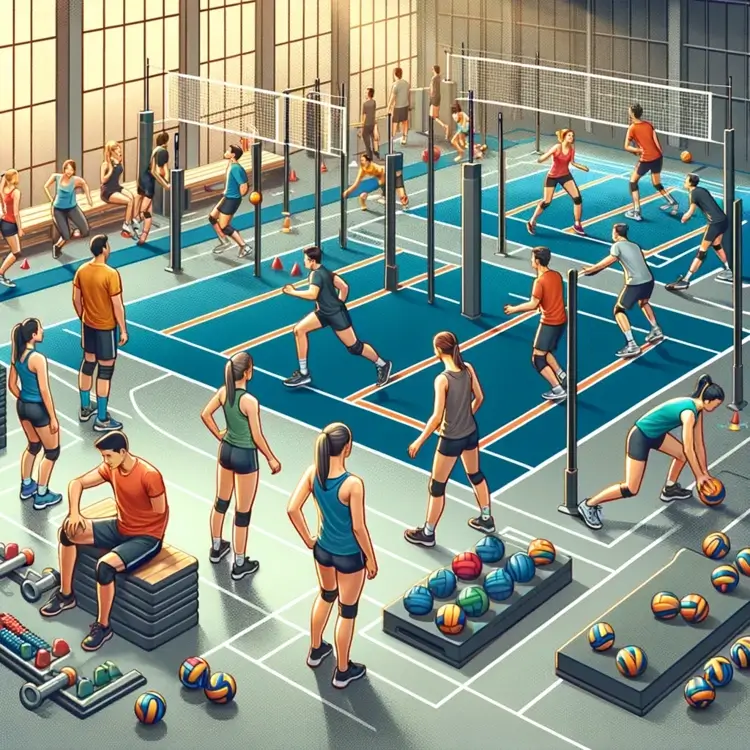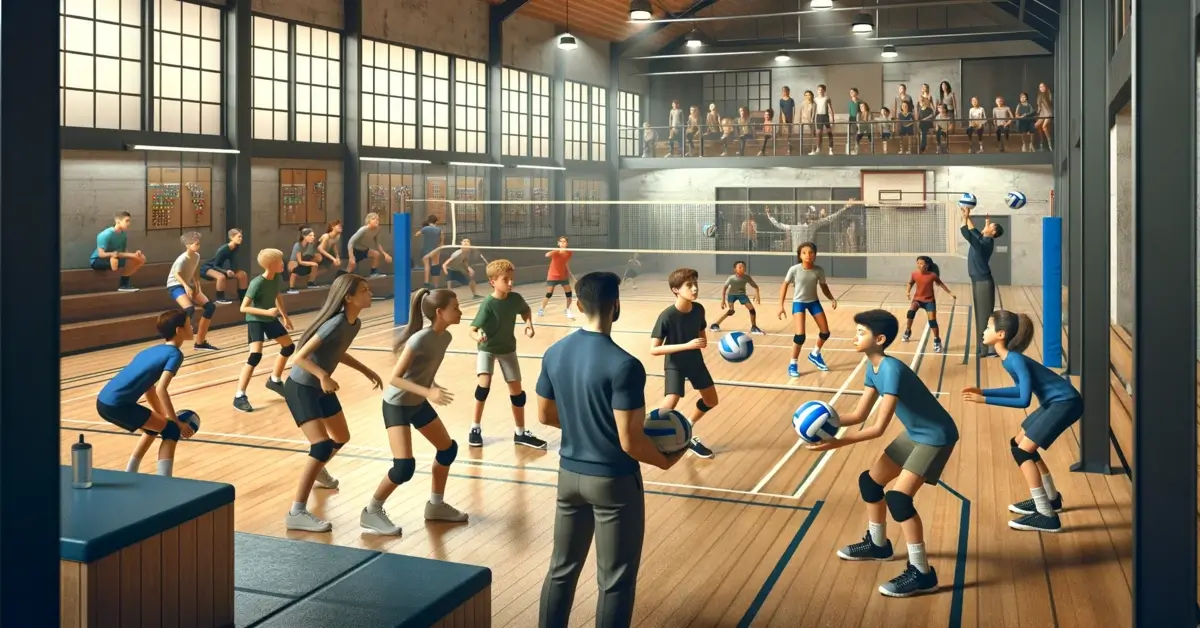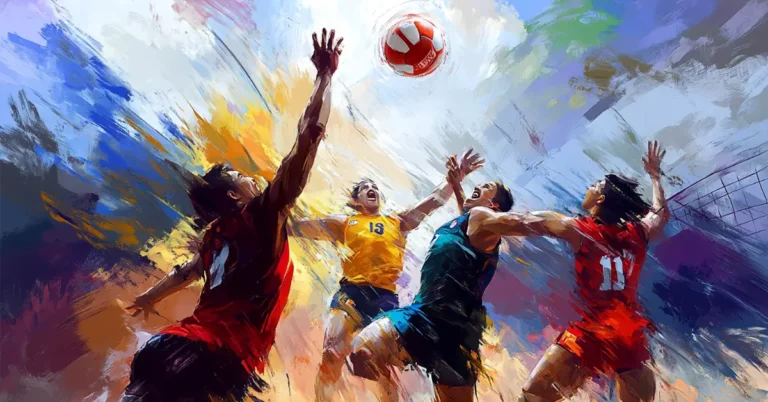Volleyball drills for middle school are essential to developing young athletes’ skills and fostering a love for the game. We understand that at this dynamic stage, learning the fundamentals of passing, serving, and movement is crucial. These foundational practices not only enhance their abilities on the court but also encourage the spirit of teamwork and the importance of consistent practice.
Through our shared experience, we recognize the importance of keeping training sessions both effective and fun to maintain engagement. By incorporating a mix of volleyball drills for middle school, we can help these young players grow in confidence and skill. Our guidance helps kids grasp not just the basics but also the strategic nuances of volleyball, paving the way for their upcoming challenges both on and off the court.
Whether you’re a coach, a teacher, or a parent, our insights into volleyball drills for middle school will equip you to guide your team or child through their learning journey. We focus on driving improvement while making sure that each practice session contributes positively to their overall development.
Understanding the Basics of Volleyball
Volleyball isn’t just a game; it’s a symphony of skills where each player’s contribution is crucial. In volleyball drills for middle school it is important to understand that the focus is about nailing the essentials to set up for success.
The Importance of Passing
Passing is the bedrock of volleyball. Every play starts with a pass, making it crucial for establishing an offense and transitioning from defense. As we teach our middle school athletes, mastering the pass—nailing the technique to control the ball’s direction and speed—is fundamental. Accurate ball control is non-negotiable, as it allows teammates to execute their plays effectively.
Serving: The Starting Point of the Game
The serve is the initial strike that sets volleyball in motion and can be a strategic advantage. In our volleyball drills for middle school, we emphasize both serving power and precision. A well-executed serve can tip the game in our favor, forcing the opposition to scramble and play on our terms. That’s why even at this budding stage, honing individual serving skills is pivotal.

The Role of the Setter
Consider the setter as the team’s strategist; their decisions can change the game. They need an excellent grasp of coordination and insights into the opponent’s formations. Their height can be an advantage, giving them a better view of the court to orchestrate plays and set the ball for attackers. Our volleyball drills for middle school focus on building the agility and strategic thinking that a setter needs to excel at their role.

If you want to dive deeper into the overview about the positions of volleyball, please check out our article here.
Volleyball Drills for Middle School to Develop Essential Skills
As we explore volleyball drills for middle school, we’re focusing on techniques that are designed to sharpen accuracy, control, and overall gameplay. Let’s break down the essential drills that can transform a middle school volleyball team.
Passing Volleyball Drills for Middle School for Accuracy and Control
Bumping Basics
- To start, align players in two lines facing each other and practice passing back and forth to build hand-eye coordination and teamwork.
Wall Passing
- Each player faces a wall, passing the ball against it and working to keep it off the ground for increased passing skills under pressure.
Serving Volleyball Drills for Middle School to Enhance Precision
Target Practice
- Place targets on the court where servers aim to hit, refining their precision and consistency.
Underhand Serving
- Have players focus on the fundamentals of an underhand serve by aiming for accuracy before power.
Setting Techniques Volleyball Drills for Middle School to Improve Timing
Setter Touches
- Players work in pairs, setting to each other at a rapid pace to improve their reaction time and setting skills.
Shadow Setting
- Without a ball, players practice the motion of setting to develop muscle memory for when they’re at the net.
Defensive and Blocking Drills
Defensive Shuffles
- Players practice shuffling their feet quickly in a defensive stance to respond to attacks effectively.
Blocking Techniques
- At the net, players jump and practice their blocking form against hitters, focusing on timing and hand positioning.
Through these volleyball drills for middle school, our young athletes will build foundational skills they need to not only succeed but also to excel in the sport.
Team Building and Communication Exercises
Mastering volleyball drills for middle school isn’t just about serving and spiking—it’s about building trust and understanding between teammates. We’ll focus on enhancing communication and teamwork through practical volleyball drills for middle school. These exercises are designed to promote both verbal and non-verbal interaction, ensuring that each member moves in sync with the rest of the team.
Communication and Movement Drills
Passing Circle:
To fine-tune communication skills, let’s form a passing circle. By arranging players in a circle and having them pass the ball to each other, we instill a sense of awareness and mutual support. The key is to call out the name of the person you’re passing to, which helps in developing strong verbal communication.
- 🎯 Goal: Improve verbal communication and ball control.
- 🙋♀️ Participants: Whole team.
- 🏐 Activity: Passing the ball and calling out names.
Trios Pass and Move:
Trios work wonders for communication and movement. In this drill, players work in groups of three, focusing on passing while constantly moving to a new spot on the court. This drill encourages players to use both verbal calls and gestures, improving their ability to pass under pressure.
Players A and B position themselves at two corners of one side of the field. Player C is beginning from one opposite corner of Player A, who has the ball. Player A now is passing the ball to Player C, who is passing across the field to the other opposite corner to Player B while running to the other corner of his side. Player B is passing the ball to Player C who again is passing the ball diagonal back to Player A. This will be continued for several times. Then the players change position.
- 🎯 Goal: Sharpen communication whilst in motion.
- 🙋♀️ Participants: Groups of three.
- 🏐 Activity: Continuous passing and moving.
Teamwork Focused Training Sessions
Run Through:
One of the engaging volleyball drills for middle school we employ, is the run through, which emphasizes teamwork and anticipation. Players must work together, predicting each other’s movements and assisting in making successful plays. The fun in this exercise is seeing how effortlessly players start to connect and move as a unit.
- 🎯 Goal: Build team dynamics and cooperative movements.
- 🙋♀️ Participants: Pairs or small groups.
- 🏐 Activity: Players alternate in running and passing.
Fun Volleyball Drills:
Lastly, incorporating fun volleyball drills for middle school can do more than teach the basics; it can knit players into a cohesive team. Whether it’s a game that involves complex teamwork or a drill that has a competitive edge, the enjoyment factor keeps players engaged and eager to work together.
- 🎯 Goal: Enhance teamwork through enjoyable activities.
- 🙋♀️ Participants: Entire team or divided into smaller teams.
- 🏐 Activity: Variable fun drills promoting team bonding.
Conditioning and Agility Training
Volleyball isn’t just about technique; it’s equally about physical preparedness. We understand that conditioning and agility are pivotal in elevating a middle schooler’s game. That’s why we place a special emphasis on volleyball drills for middle school that develop these critical areas, ensuring players can maintain their stamina throughout the match and execute defensive movements with precision.
Dynamic Volleyball Drills For Middle School for Conditioning
1. Circuit Training: One of the best known and effective – but also most hated – trainings. Set up stations that focus on different aspects of conditioning, such as jump rope for stamina and medicine ball throws for core strength. Have players rotate every few minutes to keep their heart rate up and their muscles engaged.
- Stations can include:
- Jump Rope (2 minutes)
- Medicine Ball Throws (10 throws)
- Sit-ups (1 minute)
- Push-ups (15 reps)
- Squats (20 reps)
You can change and adapt the stations however you like to, of course based on your available equipment.

2. Lateral Loading Drills: Encourage lateral movement with drills that require players to shuffle side to side swiftly. Include scenarios where they must transition from offense to defense in order to mimic in-game situations.
- Shuffle Split:
- Shuffle to the right for 10 meters and touch ground
- Sprint back to the left and play a simulated dig
Agility and Speed Workouts
1. Speed Ladder Drills: Utilize a speed ladder to enhance foot speed and agility. Players should focus on quick and precise footwork, which is essential for effective court movement.
- Quick Feet:
- In and out of each ladder square as fast as possible
- Aim for three full ladder lengths
2. Defensive Movement Practice: Implement drills that mimic game scenarios where players need to react quickly and adjust their defensive positioning.
- Defensive Slides:
- Begin in the middle of the court
- Slide to the designated position when a coach calls out the direction (e.g., “Left back!”)
- Reset after each call
By integrating these exercises into the warm-up routine, we help players improve their physical conditioning while making the process fun and engaging. Through consistent practice, players will see notable improvements in their speed, agility, and overall performance on the court.
7 Expert Secrets for Volleyball Drills for Middle School
When we coach young athletes, pinpointing the right volleyball drills for middle school can be game-changing. It sets the foundation for skilled, confident players. Here, we unveil seven expert secrets that make these drills both effective and engaging.
- Progressive Overloading: Gradually increasing the difficulty of drills helps keep students challenged but not overwhelmed. Start with basics like passing against a wall and evolve to more complex drills that improve their game sense and reaction times.
- All-inclusive Game Simulations: Simulated games provide real-world experience. Dividing the court and having them play modified games teaches strategy and quick thinking, as noted by US Sports Camps.
- Dynamic Warm-Ups: Implement exercises that mimic volleyball movements. These not only prepare the body but also engage the mind for the drills ahead.
- Skill-Specific Drills: Focus on key areas such as passing, serving, and setting. A drill like “Turn and grab” enhances agility and ball control, crucial for every player on the court.
- Peer Feedback: Encourage players to observe and give feedback to each other. It not only builds camaraderie but reinforces learning through teaching.
- Fun and Competitive Elements: Add a fun, competitive twist to drills. Whether it’s a race to complete a certain number of passes or a serving accuracy challenge, it keeps the drills exciting.
- Consistency and Routine: Regularity in practice sessions establishes a rhythm. It’s not just about the drills themselves, but how consistently they’re executed.
These secrets offer a blueprint to transform your middle school volleyball team into a well-oiled machine, with each drill tailored to develop their skills efficiently.
FAQ
Finding the right volleyball drills for middle school can be the game-changer we need for young athletes. These drills build essential skills and boost confidence as players learn the game. Let’s dive into some common questions to help enhance our coaching and players’ performance.
How do I teach my 10 year old volleyball?
The key is to start with the basics and keep it fun. Incorporate fundamental drills like wall ball for practicing serving and digging, which allows young players to develop hand-eye coordination and timing. Encourage them to focus on proper form and technique rather than power or speed at this stage.
What is the passing drill for volleyball tryouts?
During tryouts, the Passing Skills Drill is a classic. It involves players lining up and passing the ball to a target area, often a teammate or a marked spot on the floor. This not only warms them up but also allows for assessing their precision, control, and teamwork under a tryout setting.
What is butterfly drill in volleyball?
The butterfly drill is designed to improve players’ movement and passing accuracy. Players rotate in a figure-eight pattern, receiving and passing the ball before moving to the next station. This drill keeps players active, promoting agility and communication, which are crucial during matches.
How do you drill in volleyball?
Drilling in volleyball means conducting structured activities that replicate game scenarios. Effective drills for middle school focus on the core skills of passing, setting, serving, and hitting. Consistent repetition and feedback allow players to refine their technique and build muscle memory.
We hope you could find some valuable input about volleyball drills for middle schools. We would be curious about your experience: Which drills for volleyball do you like most, which one at least? Let us know in the comments.
If you liked this article you also might be interested in our post about Volleyball Hand Signals.






